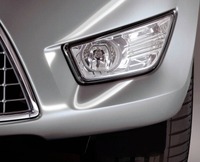Ford demonstrates results of European active safety research
 Ford's Aachen advanced research centre is part of a European research project which today presented ideas such as 'path prediction' to help vehicles best deploy safety features on frequently driven routes.
Ford's Aachen advanced research centre is part of a European research project which today presented ideas such as 'path prediction' to help vehicles best deploy safety features on frequently driven routes.Path prediction technology links a satnav system's historic data on most frequently driven routes with active safety features such as adaptive headlamps – which would be optimally controlled for known journeys' bends and corners.
The research project is PReVENT, a joint research project co-funded by the EU into improving road safety with innovative active safety systems.
Dr Wolfgang Schneider, Ford vice-president for legal, governmental and environmental affairs, said: "Apart from environmental issues, safety is the most important topic for the automotive industry. The past few decades have seen enormous progress in improving passive safety. However, the most significant improvements in vehicle safety can be expected from the implementation of major new active safety systems, which are those helping drivers to avoid accidents."
Within the framework of PReVENT, Ford demonstrated how digital data from navigation systems can be used to support future active safety systems in cars. By using detailed digital map data, the vehicle "recognises" potential hazard areas and prepares itself to react.
Lane keeping systems, in particular, can benefit from the additional information provided by digital map data. These systems are led by cameras recording lane markings. If markings are deficient or missing, eg in slip roads or intersections, the cameras alone cannot function properly. In such situations, digital data provides the necessary and accurate information to allow the lane keeping system to continue to function.
Path prediction enhances the use of digital map data from the navigation system. It is generated by analysing the daily route pattern of a driver. Through probability calculation, an on-board computer predicts a vehicle's route in advance as most people travel the same journeys every day.
Path prediction could further enhance a vehicle's adaptive headlamp system which is currently controlled solely by the steering angle. An on-board computer could learn and anticipate the angle of curves on a known route to enable adaptive headlamps to illuminate bends earlier.
PReVENT (PReVENTive and Active Safety Applications) is a four-year research project ending in January 2008 and links 54 partners from industry, public and private sectors, automobile manufacturers and suppliers. With a budget of over 55 million Euros, the PReVENT consortium is 50 per cent EU funded.

